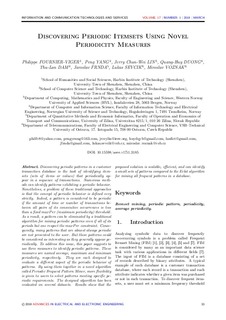Discovering Periodic Itemsets using Novel Periodicity Measures
Fournier-Viger, Philippe; Yang, Peng; Lin, Chun Wei; Duong, Quang-Huy; Dam, Thu-Lan; Frnda, Jaroslav; Sevcik, Lukas; Voznak, Miroslav
Journal article, Peer reviewed
Published version
Permanent lenke
http://hdl.handle.net/11250/2602592Utgivelsesdato
2019Metadata
Vis full innførselSamlinger
Originalversjon
Fournier-Viger, P., Yang, P., Lin, J. C.-W., Duong, Q. H., Dam, T.-L., Frnda, J., . . . Voznak, M. (2019). Discovering periodic itemsets using novel periodicity measures. Advances in Electrical and Electronic Engineering, 17(1). 10.15598/aeee.v17i1.3185Sammendrag
Discovering periodic patterns in a customer transaction database is the task of identifying itemsets (sets of items or values) that periodically appear in a sequence of transactions.
Numerous methods can identify patterns exhibiting a periodic behavior. Nonetheless, a problem of these traditional approaches is that the concept of periodic behavior is defined very strictly. Indeed, a pattern is considered to be periodic if the amount of time or number of transactions between all pairs of its consecutive occurrences is less than a fixed maxPer (maximum periodicity) threshold. As a result, a pattern can be eliminated by a traditional algorithm for mining periodic patterns even if all of its periods but one respect the maxPer constraint. Consequently, many patterns that are almost always periodic are not presented to the user. But these patterns could be considered as interesting as they generally appear periodically. To address this issue, this paper suggests to use three measures to identify periodic patterns. These measures are named average, maximum and minimum periodicity, respectively. They are each designed to evaluate a different aspect of the periodic behavior of patterns. By using them together in a novel algorithm called Periodic Frequent Pattern Miner, more flexibility is given to users to select patterns meeting specific periodic requirements. The designed algorithm has been evaluated on several datasets. Results show that the proposed solution is scalable, efficient, and can identify a small sets of patterns compared to the Eclat algorithm for mining all frequent patterns in a database.
Utgiver
Vysoka Skola Banska * Technicka Univerzita OstravaTidsskrift
Advances in Electrical and Electronic EngineeringBeslektede innførsler
Viser innførsler beslektet ved tittel, forfatter og emneord.
-
High Arctic plant phenology is determined by snowmelt patterns but duration of phenological periods is fixed: an example of periodicity
Semenchuk, Philipp R.; Gillespie, Mark; Rumpf, Sabine R.; Baggesen, Nanna; Elberling, Bo; Cooper, Elilsabeth J. (Journal article; Peer reviewed, 2016)The duration of specific periods within a plant's life cycle are critical for plant growth and performance. In the High Arctic, the start of many of these phenological periods is determined by snowmelt date, which may ... -
The inclusion of sprints in low-intensity sessions during the transition period of elite cyclists improves endurance performance 6 weeks into the subsequent preparatory period
Taylor, Madison; Almquist, Nicki Winfield; Rønnestad, Bent; Tjønna, Arnt Erik; Kristoffersen, Morten; Spencer, Matthew; Sandbakk, Øyvind; Skovereng, Knut (Peer reviewed; Journal article, 2021)Purpose: To investigate the effects of including repeated sprints in a weekly low-intensity (LIT) session during a 3-week transition period on cycling performance 6 weeks into the subsequent preparatory period (PREP) in ... -
Exclusion and inclusion of parents of hospitalized children in Norway in the period 1877–2017
Sundal, Hildegunn; Petersen, Karin Anna; Boge, Jeanne Helene (Journal article; Peer reviewed, 2019)Background: Today, Norwegian parents have the right to stay with their children when they are in hospital. This right is relatively new. The purpose of this article is to examine the nursing profession’s ideas on how parents ...

